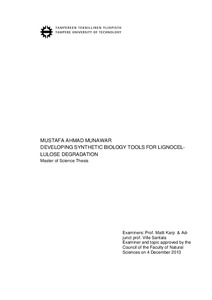Developing synthetic biology tools for lignocellulose degradation
Munawar, Mustafa Ahmad Jr (2014)
Munawar, Mustafa Ahmad Jr
2014
Master's Degree Programme in Science and Bioengineering
Luonnontieteiden tiedekunta - Faculty of Natural Sciences
This publication is copyrighted. You may download, display and print it for Your own personal use. Commercial use is prohibited.
Hyväksymispäivämäärä
2014-11-05
Julkaisun pysyvä osoite on
https://urn.fi/URN:NBN:fi:tty-201410301533
https://urn.fi/URN:NBN:fi:tty-201410301533
Tiivistelmä
Lignocellulose is mainly composed of cellulose, hemicelluloses and lignin. Lignocellulose is abundant in nature and hence an attractive low cost feedstock for bioprocesses such as biofuel production. Bioproduction initially requires separation and hydrolysis of polysaccharides content of lignocellulose. Lignocellulose is decomposed either by physiochemical means or by biodegradation. Biodegradation is accomplished by fungi and bacteria in nature.
Unfortunately production of biofuels from lignocellulose is an expensive process. To increase the economic feasibility of the process, various aspects have been focused including the biological means of degradation. In the current project, KillerRed (KR) protein was engineered and tested for its capability to degrade cellulose. The KR protein was added with a cellulose binding peptide (CBP) at its N terminal. The engineered protein CBP-KR was expressed in Escherichia coli cells using conventional expression system and purified.
The binding property of purified CBP-KR was analyzed by simply incubating the protein solution with different cellulosic substrates and observing changes in fluorescence signals after incubations. The degradation capability of CBP-KR was tested by a modified Congo red assay. The CBP-KR exhibited clear binding to printing paper but degradation of carboxymethyl cellulose (CMC) could not be recorded by the modified Congo red assay.
Unfortunately production of biofuels from lignocellulose is an expensive process. To increase the economic feasibility of the process, various aspects have been focused including the biological means of degradation. In the current project, KillerRed (KR) protein was engineered and tested for its capability to degrade cellulose. The KR protein was added with a cellulose binding peptide (CBP) at its N terminal. The engineered protein CBP-KR was expressed in Escherichia coli cells using conventional expression system and purified.
The binding property of purified CBP-KR was analyzed by simply incubating the protein solution with different cellulosic substrates and observing changes in fluorescence signals after incubations. The degradation capability of CBP-KR was tested by a modified Congo red assay. The CBP-KR exhibited clear binding to printing paper but degradation of carboxymethyl cellulose (CMC) could not be recorded by the modified Congo red assay.
